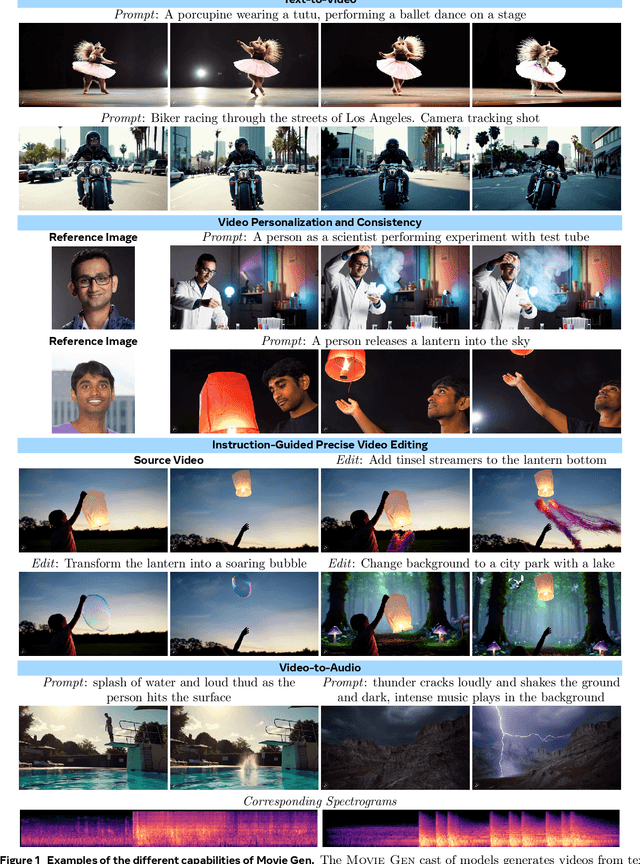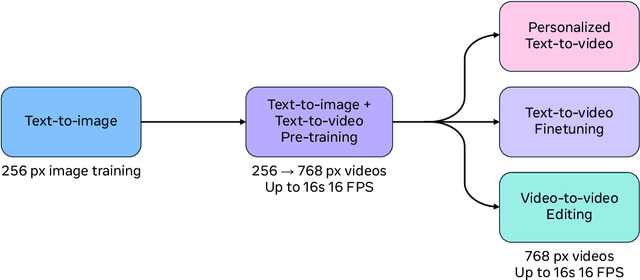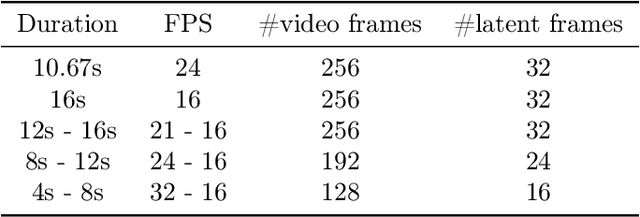Licheng Yu
Sid
Building a Mind Palace: Structuring Environment-Grounded Semantic Graphs for Effective Long Video Analysis with LLMs
Jan 08, 2025Abstract:Long-form video understanding with Large Vision Language Models is challenged by the need to analyze temporally dispersed yet spatially concentrated key moments within limited context windows. In this work, we introduce VideoMindPalace, a new framework inspired by the "Mind Palace", which organizes critical video moments into a topologically structured semantic graph. VideoMindPalace organizes key information through (i) hand-object tracking and interaction, (ii) clustered activity zones representing specific areas of recurring activities, and (iii) environment layout mapping, allowing natural language parsing by LLMs to provide grounded insights on spatio-temporal and 3D context. In addition, we propose the Video MindPalace Benchmark (VMB), to assess human-like reasoning, including spatial localization, temporal reasoning, and layout-aware sequential understanding. Evaluated on VMB and established video QA datasets, including EgoSchema, NExT-QA, IntentQA, and the Active Memories Benchmark, VideoMindPalace demonstrates notable gains in spatio-temporal coherence and human-aligned reasoning, advancing long-form video analysis capabilities in VLMs.
Apollo: An Exploration of Video Understanding in Large Multimodal Models
Dec 13, 2024



Abstract:Despite the rapid integration of video perception capabilities into Large Multimodal Models (LMMs), the underlying mechanisms driving their video understanding remain poorly understood. Consequently, many design decisions in this domain are made without proper justification or analysis. The high computational cost of training and evaluating such models, coupled with limited open research, hinders the development of video-LMMs. To address this, we present a comprehensive study that helps uncover what effectively drives video understanding in LMMs. We begin by critically examining the primary contributors to the high computational requirements associated with video-LMM research and discover Scaling Consistency, wherein design and training decisions made on smaller models and datasets (up to a critical size) effectively transfer to larger models. Leveraging these insights, we explored many video-specific aspects of video-LMMs, including video sampling, architectures, data composition, training schedules, and more. For example, we demonstrated that fps sampling during training is vastly preferable to uniform frame sampling and which vision encoders are the best for video representation. Guided by these findings, we introduce Apollo, a state-of-the-art family of LMMs that achieve superior performance across different model sizes. Our models can perceive hour-long videos efficiently, with Apollo-3B outperforming most existing $7$B models with an impressive 55.1 on LongVideoBench. Apollo-7B is state-of-the-art compared to 7B LMMs with a 70.9 on MLVU, and 63.3 on Video-MME.
Accelerating Multimodel Large Language Models by Searching Optimal Vision Token Reduction
Nov 30, 2024



Abstract:Prevailing Multimodal Large Language Models (MLLMs) encode the input image(s) as vision tokens and feed them into the language backbone, similar to how Large Language Models (LLMs) process the text tokens. However, the number of vision tokens increases quadratically as the image resolutions, leading to huge computational costs. In this paper, we consider improving MLLM's efficiency from two scenarios, (I) Reducing computational cost without degrading the performance. (II) Improving the performance with given budgets. We start with our main finding that the ranking of each vision token sorted by attention scores is similar in each layer except the first layer. Based on it, we assume that the number of essential top vision tokens does not increase along layers. Accordingly, for Scenario I, we propose a greedy search algorithm (G-Search) to find the least number of vision tokens to keep at each layer from the shallow to the deep. Interestingly, G-Search is able to reach the optimal reduction strategy based on our assumption. For Scenario II, based on the reduction strategy from G-Search, we design a parametric sigmoid function (P-Sigmoid) to guide the reduction at each layer of the MLLM, whose parameters are optimized by Bayesian Optimization. Extensive experiments demonstrate that our approach can significantly accelerate those popular MLLMs, e.g. LLaVA, and InternVL2 models, by more than $2 \times$ without performance drops. Our approach also far outperforms other token reduction methods when budgets are limited, achieving a better trade-off between efficiency and effectiveness.
ROICtrl: Boosting Instance Control for Visual Generation
Nov 27, 2024



Abstract:Natural language often struggles to accurately associate positional and attribute information with multiple instances, which limits current text-based visual generation models to simpler compositions featuring only a few dominant instances. To address this limitation, this work enhances diffusion models by introducing regional instance control, where each instance is governed by a bounding box paired with a free-form caption. Previous methods in this area typically rely on implicit position encoding or explicit attention masks to separate regions of interest (ROIs), resulting in either inaccurate coordinate injection or large computational overhead. Inspired by ROI-Align in object detection, we introduce a complementary operation called ROI-Unpool. Together, ROI-Align and ROI-Unpool enable explicit, efficient, and accurate ROI manipulation on high-resolution feature maps for visual generation. Building on ROI-Unpool, we propose ROICtrl, an adapter for pretrained diffusion models that enables precise regional instance control. ROICtrl is compatible with community-finetuned diffusion models, as well as with existing spatial-based add-ons (\eg, ControlNet, T2I-Adapter) and embedding-based add-ons (\eg, IP-Adapter, ED-LoRA), extending their applications to multi-instance generation. Experiments show that ROICtrl achieves superior performance in regional instance control while significantly reducing computational costs.
Movie Gen: A Cast of Media Foundation Models
Oct 17, 2024



Abstract:We present Movie Gen, a cast of foundation models that generates high-quality, 1080p HD videos with different aspect ratios and synchronized audio. We also show additional capabilities such as precise instruction-based video editing and generation of personalized videos based on a user's image. Our models set a new state-of-the-art on multiple tasks: text-to-video synthesis, video personalization, video editing, video-to-audio generation, and text-to-audio generation. Our largest video generation model is a 30B parameter transformer trained with a maximum context length of 73K video tokens, corresponding to a generated video of 16 seconds at 16 frames-per-second. We show multiple technical innovations and simplifications on the architecture, latent spaces, training objectives and recipes, data curation, evaluation protocols, parallelization techniques, and inference optimizations that allow us to reap the benefits of scaling pre-training data, model size, and training compute for training large scale media generation models. We hope this paper helps the research community to accelerate progress and innovation in media generation models. All videos from this paper are available at https://go.fb.me/MovieGenResearchVideos.
The Llama 3 Herd of Models
Jul 31, 2024Abstract:Modern artificial intelligence (AI) systems are powered by foundation models. This paper presents a new set of foundation models, called Llama 3. It is a herd of language models that natively support multilinguality, coding, reasoning, and tool usage. Our largest model is a dense Transformer with 405B parameters and a context window of up to 128K tokens. This paper presents an extensive empirical evaluation of Llama 3. We find that Llama 3 delivers comparable quality to leading language models such as GPT-4 on a plethora of tasks. We publicly release Llama 3, including pre-trained and post-trained versions of the 405B parameter language model and our Llama Guard 3 model for input and output safety. The paper also presents the results of experiments in which we integrate image, video, and speech capabilities into Llama 3 via a compositional approach. We observe this approach performs competitively with the state-of-the-art on image, video, and speech recognition tasks. The resulting models are not yet being broadly released as they are still under development.
SceneTextGen: Layout-Agnostic Scene Text Image Synthesis with Diffusion Models
Jun 03, 2024



Abstract:While diffusion models have significantly advanced the quality of image generation, their capability to accurately and coherently render text within these images remains a substantial challenge. Conventional diffusion-based methods for scene text generation are typically limited by their reliance on an intermediate layout output. This dependency often results in a constrained diversity of text styles and fonts, an inherent limitation stemming from the deterministic nature of the layout generation phase. To address these challenges, this paper introduces SceneTextGen, a novel diffusion-based model specifically designed to circumvent the need for a predefined layout stage. By doing so, SceneTextGen facilitates a more natural and varied representation of text. The novelty of SceneTextGen lies in its integration of three key components: a character-level encoder for capturing detailed typographic properties, coupled with a character-level instance segmentation model and a word-level spotting model to address the issues of unwanted text generation and minor character inaccuracies. We validate the performance of our method by demonstrating improved character recognition rates on generated images across different public visual text datasets in comparison to both standard diffusion based methods and text specific methods.
Animated Stickers: Bringing Stickers to Life with Video Diffusion
Feb 08, 2024



Abstract:We introduce animated stickers, a video diffusion model which generates an animation conditioned on a text prompt and static sticker image. Our model is built on top of the state-of-the-art Emu text-to-image model, with the addition of temporal layers to model motion. Due to the domain gap, i.e. differences in visual and motion style, a model which performed well on generating natural videos can no longer generate vivid videos when applied to stickers. To bridge this gap, we employ a two-stage finetuning pipeline: first with weakly in-domain data, followed by human-in-the-loop (HITL) strategy which we term ensemble-of-teachers. It distills the best qualities of multiple teachers into a smaller student model. We show that this strategy allows us to specifically target improvements to motion quality while maintaining the style from the static image. With inference optimizations, our model is able to generate an eight-frame video with high-quality, interesting, and relevant motion in under one second.
FlowVid: Taming Imperfect Optical Flows for Consistent Video-to-Video Synthesis
Dec 29, 2023Abstract:Diffusion models have transformed the image-to-image (I2I) synthesis and are now permeating into videos. However, the advancement of video-to-video (V2V) synthesis has been hampered by the challenge of maintaining temporal consistency across video frames. This paper proposes a consistent V2V synthesis framework by jointly leveraging spatial conditions and temporal optical flow clues within the source video. Contrary to prior methods that strictly adhere to optical flow, our approach harnesses its benefits while handling the imperfection in flow estimation. We encode the optical flow via warping from the first frame and serve it as a supplementary reference in the diffusion model. This enables our model for video synthesis by editing the first frame with any prevalent I2I models and then propagating edits to successive frames. Our V2V model, FlowVid, demonstrates remarkable properties: (1) Flexibility: FlowVid works seamlessly with existing I2I models, facilitating various modifications, including stylization, object swaps, and local edits. (2) Efficiency: Generation of a 4-second video with 30 FPS and 512x512 resolution takes only 1.5 minutes, which is 3.1x, 7.2x, and 10.5x faster than CoDeF, Rerender, and TokenFlow, respectively. (3) High-quality: In user studies, our FlowVid is preferred 45.7% of the time, outperforming CoDeF (3.5%), Rerender (10.2%), and TokenFlow (40.4%).
Fairy: Fast Parallelized Instruction-Guided Video-to-Video Synthesis
Dec 20, 2023



Abstract:In this paper, we introduce Fairy, a minimalist yet robust adaptation of image-editing diffusion models, enhancing them for video editing applications. Our approach centers on the concept of anchor-based cross-frame attention, a mechanism that implicitly propagates diffusion features across frames, ensuring superior temporal coherence and high-fidelity synthesis. Fairy not only addresses limitations of previous models, including memory and processing speed. It also improves temporal consistency through a unique data augmentation strategy. This strategy renders the model equivariant to affine transformations in both source and target images. Remarkably efficient, Fairy generates 120-frame 512x384 videos (4-second duration at 30 FPS) in just 14 seconds, outpacing prior works by at least 44x. A comprehensive user study, involving 1000 generated samples, confirms that our approach delivers superior quality, decisively outperforming established methods.
 Add to Chrome
Add to Chrome Add to Firefox
Add to Firefox Add to Edge
Add to Edge